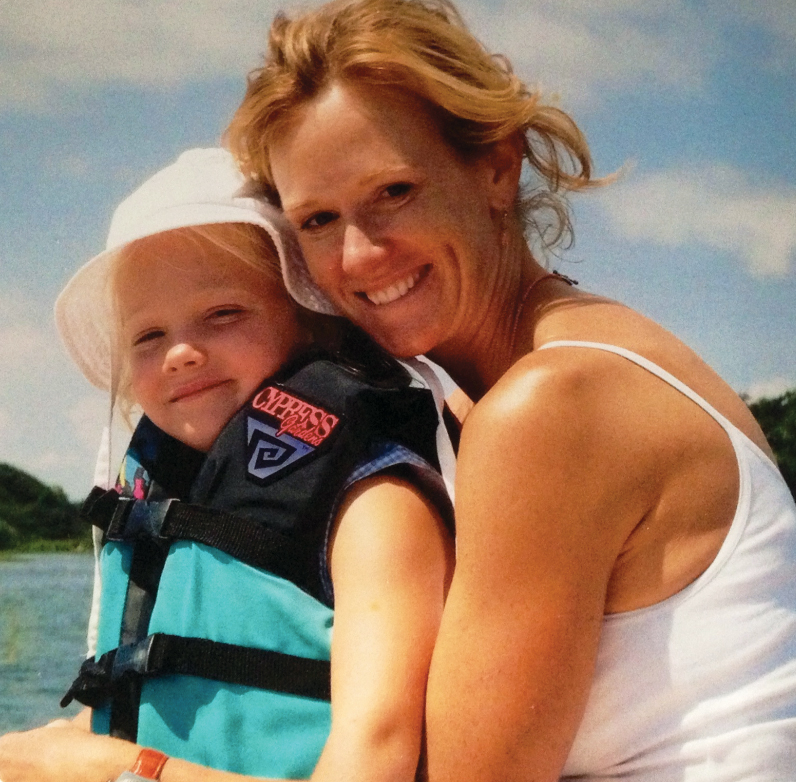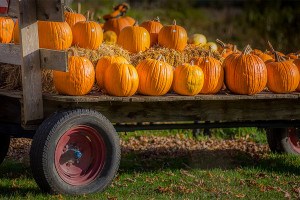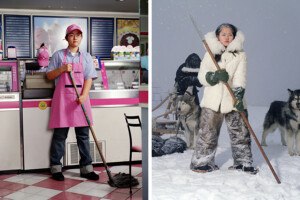Life After Charlotte

Sukey Forbes with Charlotte in July 2004.
As we tried to formulate our survival plan, my first thought was that we had to get back to Naushon. In part this was a matter of getting back on the horse that had thrown us. We had been on the island just before Charlotte’s death, and I didn’t want to have a place so sacred to me tainted with those sad associations. But more than that, Naushon had always been the place where life had made the most sense. The palpable presence of ancestors. The soothing of natural rhythms. The structure was so solid and secure that you went with it without question. You didn’t have to do anything. It was enough to simply be.
The ferry itself is 56 feet, with a wheelhouse for passengers and a freight deck that can accommodate two pickups or one long oil truck. The ride is all of 15 minutes—20 if you stop at Uncatena—but each time the captain backs away from the dock and turns hard to starboard I always have the exalted feeling of embarking on a great journey. That’s the magic of islands. The smell of the sea air assaults your senses and the tension fades from your body the instant you leave the mainland.
Catholics have the stations of the cross and their rosaries. I’ve always had the ritual of leaving Woods Hole and heading out past the ledges, past Penzance Point, with all its fabulous houses and the terra-cotta-roofed Mellon estate—the same route each time.
It’s a complicated waterway, one primary east-to-west passage with a fork that runs southeast, but, barring serious fog, you can see your destination the whole time. Then there’s a quarter mile of open water and then another set of ledges marking the outer part of Hadley Harbor, and all along there are familiar channel markers, nuns and cans and spindles with birds and sometimes dolphins and seals.
We stood on the railing, Cabot and Beatrice in their life jackets, looking out to where the horses were grazing on Nonamesset. Then we went through the narrows and I could see the red boathouse and the big stone house with a large widow’s walk on the hill, a sight I never grow tired of seeing. I was home.
Naushon is actually a series of islands—Monohansett, Uncatena, Naushon, Veckatimest, Nonamesset—connected by footbridges. Ice Age glaciers had formed them by scraping debris into a long ridge, known as a terminal moraine, that extends into Buzzards Bay on a southwest heading of 60 degrees. Hills rise up to 200 feet, often topped with sand, but also mixed with huge boulders of granite and gneiss. This landscape is punctuated by “kettle holes,” formed when big chunks of ice hung around and displaced the rock that otherwise would have settled in. Some of these deep impressions became ponds.
I walked through the woods and out toward the south shore, then past the owl’s nest high up in the beech tree in the woods. Shortly afterward, I came up the hill to the main road, then crossed onto Eagle Hollow path and headed back along the north shore.
The path then took me past the collection of boulders that had been a ceremonial circle for the Wampanoags long before our family’s tenure on the island. I knew very little about the beliefs of these Native Americans, but I did know that their religion (like mine) encompassed both the natural and the supernatural worlds, and that it was very much grounded in a sense of place—this place. I had done so much living here. I had always felt so alive here. Now I felt utterly numb, bereft, and diminished. What was I going to do? The choices seemed basic and slim: Die. Exist. Live. I wanted to die, but with two young children to care for and a husband, that wasn’t an option. Exist. I could do that. I was doing that now. But how flat and lifeless.
How dreary and endless the long march would be until I met Charlotte again. The only option that resonated with me was to live. But how? How to get there from here? To feel the fullness of life again seemed a Sisyphean task and yet I knew that somehow I had to get there. I would do whatever it took. And when I got there, I would reflect on it and hopefully help others behind me on the path. I wanted to want to live. That was the best I could do in that moment. I decided step one would be to fake it until I could make it.
The first bridge is over the lagoon, also called the Southeast Gutter, which offers a very different experience depending on whether the 4-foot tide is high or low, coming or going. Just two weeks earlier Charlotte and I had been swimming here, jumping off the bridge to ride the tide surging beneath as it rushed out to sea. How can this be, I wondered? How can the world change so suddenly, so absolutely, so irrevocably?
Emerson had walked these same paths, and he had mused over similar mysteries, and, like me, he had not found it easy to emote.
“I chiefly grieve that I cannot grieve,” he wrote after the death of his son. “I comprehend nothing of this fact but its bitterness. Explanation, I have none, consolation none that rises out of the fact itself; only diversion; only oblivion of this and pursuit of new objects.” Yes, I thought. But help me. Fix me. You who were here before. Help me.
I lay down on the grass, face-down, taking Livingston’s advice about being grounded one step further. Emerson said that the use of natural history is to give us aid in supernatural history. He also said that the outer creation was to give us the language for the inward creation. Surely I was every bit as desperate as he had been for some deeper understanding of the incredible rupture that had taken place in my life. If I couldn’t make sense of it through logic, I was willing to try osmosis, photosynthesis—anything. If it would help me break through the numbness and embrace the pain and truly feel it and then get beyond it, I was ready to worship thunder and pray to trees.
The trouble remained—I was a religious community of one, without sufficient teaching or ritual to fall back on. I needed a spirit guide, and I had no idea where to find one.
After a time I got up and continued my walk, then went back to check on Cabot and Beatrice. When I got to the house I found Michael sitting on the porch with a yellow legal pad, his father a few feet away in a rocker, two generations grieving together.
“What’re you doing?” I asked.
He showed me the drawing on the pad.
“For Charlotte,” he said.

Charlotte and her siblings pose together in the summer of 2004.
It was a design for a playhouse, surrounded by formal plantings. There had once been a stable between Mansion House and the meadow that now served as a soccer field. Michael had mentioned in passing that he wanted to build a memorial garden there for Charlotte. Now he seemed deeply into it.
“Nothing that needs a lot of maintenance,” he said. “We have to keep it simple. After we’re gone it can’t fall into neglect and become a jungle.”
He was being wise to plan ahead. At Stone House, Emerson’s daughter Edith had built a circular garden, enclosed by a high stone wall and accessed by an iron gate. Five generations later it had gone from lovingly tended to a tangle of weeds that was now almost impossible to enter. As children, we pretended that it was the Secret Garden, à la Frances Hodgson Burnett.
My mother had the kids under control, so I went into the parlor and sat down with one of the guest books I’d brought down to the island to read. These ancient ledgers were made for keeping accounts, bound in leather with “Naushon” embossed in gold leaf on the front.
For nearly two centuries the benchmarks in family history had been collected here. Reading the entries in old faded script has always been a rainy-day activity for me. And given the cast of characters who’ve passed through, there are treasures to be found, most with a summery, magical feel. Herman Melville’s was typical in that regard:
Sweet shall be the memory of Naushon.
Tuesday, July 13, 1852
Blue sky—blue sea—& almost everything blue but our spirits.
There were also autumn entries of deer-hunting parties.
Guests like Emerson and Oliver Wendell Holmes would compose poems to recite at the evening’s formal hunt dinners and then write them in the book for future reference.
But this day I wasn’t browsing for literary footnotes. I was desperately seeking guidance from my ancestors about life, and death, and grieving, and the meaning of it all.
Knowing that the American Civil War had been a time of great loss and anxiety, I began to look through the pages of a volume that held entries from these dates. Fairly quickly my eyes fell on the familiar and practically indecipherable handwriting of my great-great-great-grandfather Ralph Waldo Emerson. The entry was a poem he had written during his visit on the island. The title, “Waldeinsamkeit,” I later learned, refers to the process of transcending the individual self to find a healthy relationship with the universal spiritual dimension arrived at generally through solitude in the forest and meditation. The word Einsamkeit, without the Wald in front of it, describes one who is locked inside oneself and is thus driven mad. I feared I was the latter but hoped to one day have the ability to become the former. It took quite some time to painstakingly transcribe the words in ink, but I was determined to make it through the poem in its entirety. Reading the first stanza was the closest I had come to an “aha” moment with my ancestor Emerson’s writings:
I do not count the hours I spend
In wandering by the sea.
The forest is my loyal friend,
Like God it useth me.
There were also collections of letters, including one from Great-Great- Grandfather William Hathaway Forbes himself, the former prisoner of the Civil War, about the death of his own son Don, whose appendix had ruptured on this island on his 18th birthday. Though he died almost a hundred years prior to my birth, I knew this young man’s features as well as my own because I’ve been drawing my fingers across the smooth plaster cheekbones of his death mask in the attic since I was a child.
“Yes, these are sad anniversaries,” William Hathaway Forbes wrote. “I do not believe that our loved ones perish but that they begin another life, and our hope is inextinguishable that we shall be with them again.”
The summer that Don died, his mother, Edith Emerson, wrote about going up to the “fort” he’d built on what’s now called Don’s Hill. She tells of filling his room with flowers and candles each year on the anniversary of his death, which, of course, was also the anniversary of his birth.
But, as moving as these documents were, the most haunting account I found was written by Sarah Forbes’s cousin Robert Swain, the man whose death allowed Naushon to pass entirely into Forbes family ownership.
Robert Swain’s death at 21 had been one of the classic romantic tubercular episodes of that era. He had suffered much, through many trips to warmer climates, with a stiff upper lip and many sentiments expressed throughout. Supposedly his last words were: “I go to join our dear friends who have gone before me, and they are not a few. We shall meet again in a better world.”
But a week before the end, just before his tuberculosis took a critical turn, he wrote this:
At one time, during this last attack of hemorrhage, I felt that I was dying. Everything grew dim before my eyes. My memory failed me. I could not think of the next word I wished to say, and I could not utter the one upon my lips. A delightful feeling of peace, of freedom from all pain and suffering, of withdrawal from the world, came over me. My mind was perfectly clear. I had no thought of returning to life! This, then, is death, and now, I thought, nothing but the last rattle in the throat is wanting before my spirit takes its flight. And I listened to hear it. The thoughts, the feelings of that one instant of time were such as could not be in any other instant in life. The change, the great change, now is. With what an agony of expectation, of hope, of wonder, did my mind turn upon itself, to feel its own change, to follow out, as it were, its own identity, through the changes it was to pass through. This was all over in one instant. By the last efforts of nature, a cough threw the blood from my lungs, and I revived again. It was very painful to return to so much suffering, and the sensation was of unmingled regret.
Robert’s story laid the foundation for a new path for me. I was intrigued by his intimations of an afterlife, and comforted by the bliss he found in his glimpse of it.


